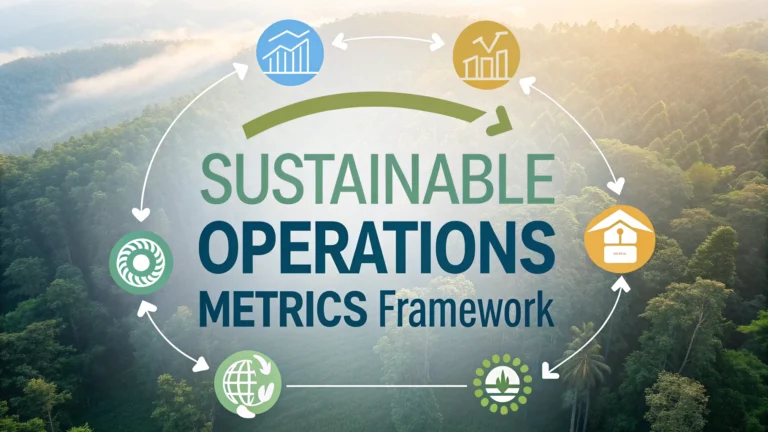A Sustainable Operations Metrics Framework helps organizations measure, track, and improve their environmental and social impact while maintaining operational efficiency.
This guide explores key performance indicators (KPIs) and measurement systems that chief operating officers can implement to drive sustainability initiatives across their organizations.
By adopting these metrics, COOs can align operational excellence with environmental stewardship, creating long-term value for stakeholders while reducing environmental impact.
Essential Metrics Categories
- Environmental Impact
- Carbon emissions (Scope 1, 2, and 3)
- Energy consumption
- Water usage
- Waste management
- Resource Efficiency
- Raw material utilization
- Recycling rates
- Renewable energy adoption
- Social Impact
- Worker safety metrics
- Community engagement
- Supply chain labor practices
Implementation Steps
- Baseline Assessment: Document current performance across all metrics
- Goal Setting: Establish realistic targets aligned with industry standards
- Data Collection Systems: Deploy monitoring tools and software
- Regular Reporting: Create dashboard templates for stakeholder updates
- Continuous Improvement: Review and adjust targets periodically
Recommended Tools and Resources
| Tool Type | Examples | Use Case |
|---|---|---|
| Carbon Tracking | GHG Protocol, CDP | Emissions measurement |
| Energy Management | EnergyStar Portfolio Manager | Energy efficiency monitoring |
| Sustainability Reporting | GRI Standards, SASB | Stakeholder communication |
Best Practices for Success
Integrate sustainability metrics into existing operational KPIs rather than treating them as separate measures.
Establish clear ownership and accountability for each metric within the organization.
Train staff on data collection procedures and reporting requirements to ensure accuracy.
Review industry benchmarks and adjust targets based on peer performance and technological advancements.
Common Challenges and Solutions
- Data Quality Issues
- Solution: Implement automated data collection systems
- Regular data validation checks
- Resource Constraints
- Solution: Phase implementation over time
- Focus on high-impact metrics first
- Stakeholder Buy-in
- Solution: Demonstrate ROI through pilot programs
- Regular communication of success stories
Moving Forward with Sustainable Operations
Contact sustainability consulting firms like ERM, WSP, or KPMG for professional guidance on framework implementation.
Join industry groups such as the World Business Council for Sustainable Development (WBCSD) to stay current with best practices.
Consider certification programs like ISO 14001 to validate your environmental management system.
Partner with local environmental organizations to strengthen community engagement and impact measurement.
Measuring Success and ROI
Track financial benefits alongside environmental improvements to demonstrate the business case for sustainability initiatives:
- Cost savings from reduced resource consumption
- Revenue growth from sustainable products
- Risk mitigation value
- Enhanced brand reputation metrics
Integration with Digital Transformation
Leverage technology to enhance sustainability tracking and reporting:
- IoT sensors for real-time monitoring
- AI-powered predictive analytics
- Blockchain for supply chain transparency
- Digital twins for optimization
Stakeholder Engagement Strategies
Internal Stakeholders
- Employee training programs
- Sustainability champions network
- Department-specific KPIs
External Stakeholders
- Investor relations updates
- Customer communication channels
- Supplier engagement programs
Building a Sustainable Future
Sustainable operations metrics are essential tools for modern business leadership. By implementing comprehensive measurement frameworks, organizations can:
- Drive meaningful environmental and social impact
- Create competitive advantages
- Meet evolving stakeholder expectations
- Position for long-term success in a carbon-constrained economy
Regular assessment and refinement of these metrics ensure continuous improvement and adaptation to changing sustainability challenges and opportunities.
FAQs
- What key metrics should be included in a Sustainable Operations Framework?
Core metrics include energy consumption, water usage, waste generation and recycling rates, carbon emissions, renewable energy adoption, supply chain sustainability scores, and resource efficiency ratios. - How often should sustainable operations metrics be reviewed and updated?
Metrics should be reviewed quarterly for operational adjustments and annually for strategic planning, with real-time monitoring of critical environmental indicators when possible. - What role does the Chief Operating Officer play in sustainable operations?
The COO oversees implementation of sustainability initiatives, ensures operational alignment with environmental goals, manages resource allocation, and coordinates between departments to achieve sustainability targets. - How can companies measure the ROI of sustainable operations initiatives?
ROI can be measured through cost savings from reduced resource consumption, increased operational efficiency, improved regulatory compliance, enhanced brand value, and reduced environmental risks. - What certifications and standards should be considered for sustainable operations?
Key certifications include ISO 14001 Environmental Management, ISO 50001 Energy Management, LEED certification, and industry-specific sustainability standards like GRI (Global Reporting Initiative). - How can sustainable operations metrics be integrated with existing KPIs?
Integration involves aligning sustainability metrics with operational KPIs, incorporating them into performance dashboards, and linking them to business objectives and departmental goals. - What technology solutions support sustainable operations measurement?
Technologies include Environmental Management Systems (EMS), IoT sensors for real-time monitoring, sustainability reporting software, energy management systems, and data analytics platforms. - How can companies ensure accurate data collection for sustainable operations metrics?
Implement automated data collection systems, establish clear measurement protocols, conduct regular audits, train staff on proper data collection methods, and use third-party verification when necessary. - What are the best practices for reporting sustainable operations metrics to stakeholders?
Use standardized reporting frameworks, ensure transparency, provide context for metrics, highlight progress toward goals, and maintain consistent reporting frequencies. - How can sustainable operations metrics drive continuous improvement?
By setting baseline measurements, establishing improvement targets, implementing feedback loops, conducting regular performance reviews, and adjusting strategies based on metric insights.
